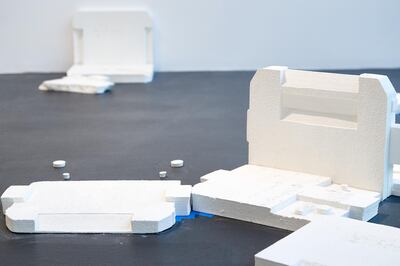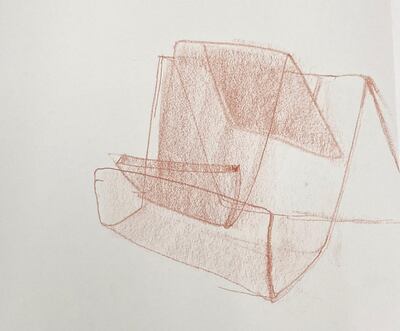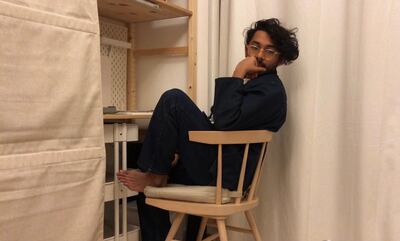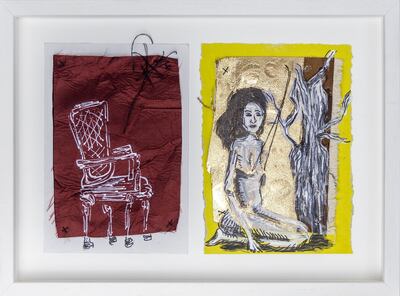Over the past few years, via programmes such as the Salama bint Hamdan Emerging Artists Fellowship (Seaf), Campus Art Dubai, the Youth Takeover by Jameel Arts Centre, and new art and visual culture programmes at Zayed University and American University in Dubai, a new generation of artists have been emerging in the UAE.
These artists are looking at subjects such as the formation of memories, emotions, folkloric tales, science-fiction, techno-progressivism and the value of painstaking, labor-intensive craft practices. If that seems like a broad list, it is: the amount of young artists across Dubai, Sharjah and Abu Dhabi is mushrooming, and any attempt to summarise the focus of their inquiries will happily fall short.
With that in mind, here are a few of the artists The National has its eye on.
Moza Al Matrooshi
The Dubai-born artist recently returned from London where she received an MFA at the Slade School Art. Her work investigates the particularities embedded in language, via food. For the Lahore Biennale, she screened the video Glaze, of sweets sellers in Sharjah, at a Lahore tea house. A menu provided some of the food in the video so that the work could be literally consumed. Her other performances act as social experiments, testing to what extent food can be separated from the social life it gives rise to.
Sarah Al Mehairi
Raised in Abu Dhabi, Sarah Al Mehairi graduated in 2019 from NYUAD, and had her first solo show at Carbon 12 even before she finished her fellowship at Seaf. Her formal, puzzle-like sculptures of different shades of wood appear like painterly abstractions, which she underscores by staining the wood in different colours to achieve a trompe-l'oeil effect. For a series of plasterworks, A Filled Form is Familiar, now up at the Seaf show at Warehouse421, she cast a Styrofoam box in plaster 40 times in plaster, changing one element of the composition each time, so there is no original to the series.
Mariam Al Zayani & Nasser Al Zayani
The Bahraini-American brother and sister were commissioned by the Youth Takeover to show at Jameel Arts Centre, where they installed works throughout the buildings so that visitors would move through the pair's disjunctive memories. They continued this theme in a workshop, where they investigated how memory can live between people. They asked pairs of family members to recall an experience separately and together, co-creating a third document that amalgamated both member's reminiscences. Memory also inflects Nasser's individual work, such as when he cast script into tablets of crumbling sand.
Mona Ayyash
The Palestinian artist, who was raised in Dubai, is interested in the media imagery around sport, produced as a spectacle but given to smaller moments of stillness and even boredom. She took moments from found footage – a gymnast circling a bar, a swimmer diving into the water – and looped them, so that the forward momentum of the athletes was trapped, and their goal-orientated actions transformed simply into a mechanism of display. At the exhibition of this work, at the UAE Unlimited show Tashweesh at the Maraya Art Centre in 2019, she added bleachers to the video, inviting the audience to sit as sports fans for this truncated imagery. Ayyash is currently an artist-in-residence at Warehouse421.
Nadine Ghandour
The Egyptian artist, who lives and works in Dubai, reflects the world around her in the abstract language of shapes, rendered in charcoal drawings and Plasticine sculptures. Her work pays attention to the spaces in between or the proportions of a room, and considers how they might direct our experience without our even being aware. Working also as part of Office Run, with Ayyash, her work also has a curatorial dimension, converting disused spaces into sites of potential collaboration.
Sree
An Indian artist raised in Dubai, Sree recently made a work invoking Dubai through smell: pools of ground turmeric lay on the floor of the Jameel Arts Centre during its Youth Takeover. Across the wall, a video played of the city, shot from a low vantage point as if via the eyes of a child. The work, 1958_sand, took its title from the year the first Hindu temple was inaugurated in Dubai. It crosses this historic, if forgotten event with the domesticity of childhood memories. Looking back isn't easy: the smell of the turmeric was overpowering.
Mohamed Khalid
A graduate of Campus Art Dubai and the Seaf programme, Mohamed Khalid casts his eye on everyday items –those sold on Dubizzle or discarded receipts – and coaxes out of them their metaphoric potential. The malfunction of receipts from parking machines at Dubai Mall becomes a stand-in for the role of the artist, gumming up the societal machine but somehow failing, he says, to make a real difference. At the Jameel Arts Centre's Youth Takeover, Khalid overlaid graphite panels in the lift, mimicking those in his apartment block's lifts, which he saw as ad hoc message boards for unprompted exclamations such as "I love the UAE" or "I love Pakistan". The work turned out to be more successful than he or the curators had expected: by the end of the show, the panels had been etched with graffiti.
Tala Khalil
A Palestinian artist raised in the UAE, Khalil is interested in identity and heritage as living, changing practices. For the Jameel Arts Centre's Youth Takeover recently, part of her contribution was a workshop in how to dance the dabke, which took place online and outside in the centre's sculpture park. Elsewhere she works in a host of media, from writing to experimental film, installations, photography to understanding how traditions mediate between the individual and the collective. Her posterShu Baarfni (How Would I Know?) was one of the winners of the 100 Best Arabic Posters in 2018, shown at Warehouse421.
Augustine Paredes
The Filipino-born photographer documents life in Dubai, imbuing the city with the romanticism of the after dark hours. He has an eye for finding glamour in hidden places, and indeed the artist has also worked commercially for brands such as Gucci and Les Benjamins. For his contribution to A Picture Held Us Captive, the show curated by Nada Raza for Abu Dhabi Art, he read from his book of poetry Conversations at the End of the Universe. The story is a performance of empathy, segueing from his learning of a friend's unexpected death to reminiscences of his mother, talking to her husband at his graveside. Paredes is currently making a body of work about Mina Zayed with fellow participants of the W421 x GPP Photography Mentorship Programme. It will be on show at Gulf Photo Plus and Warehouse421 next year.
Malda Smadi
Smadi, who was born in Damascus and grew up in Dubai, began at Seaf with a portraiture practice that has expanded outwards into portraiture in the widest sense: paintings, photographs, drawings of people and the way they live and feel. Showing in the current sale on the 101 art platform, her drawings of women branch out into threads sewn on to collaged fabric, while a new series of work tackles the fear and dread experienced by many this year. Smadi also compiles In Transit Archives, in which she records a series of conversations with women in the UAE, discussing stories
that concern them.













